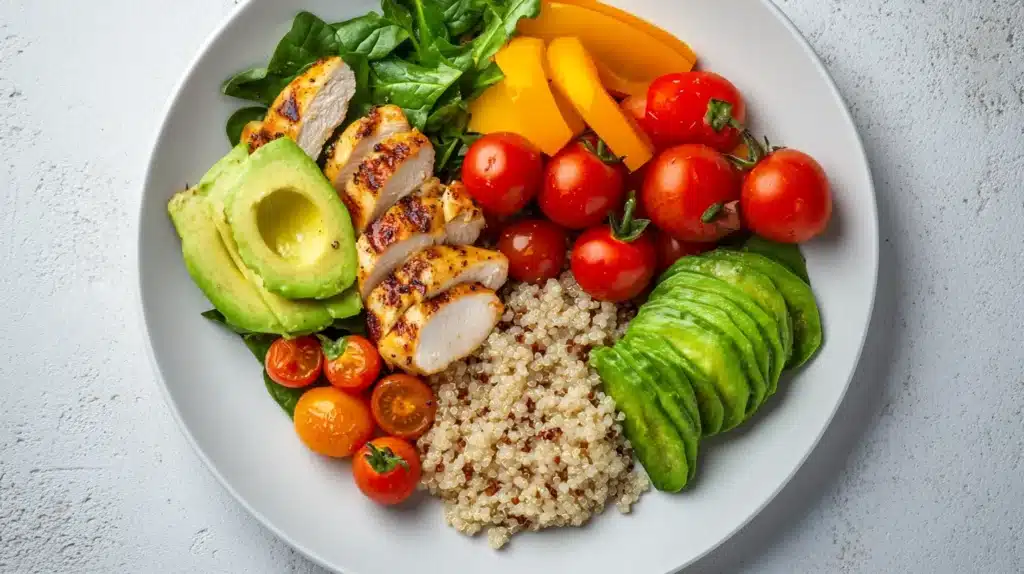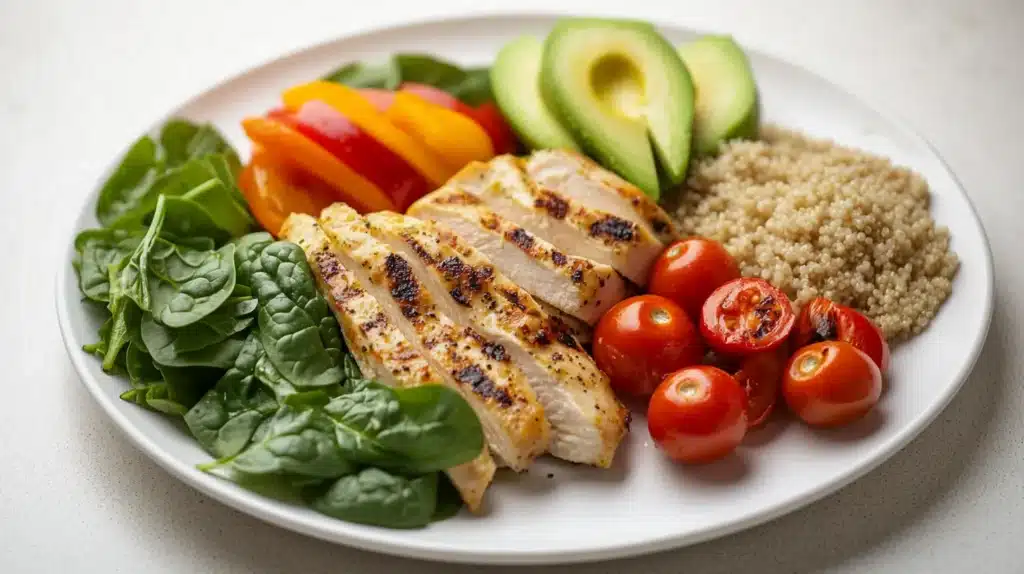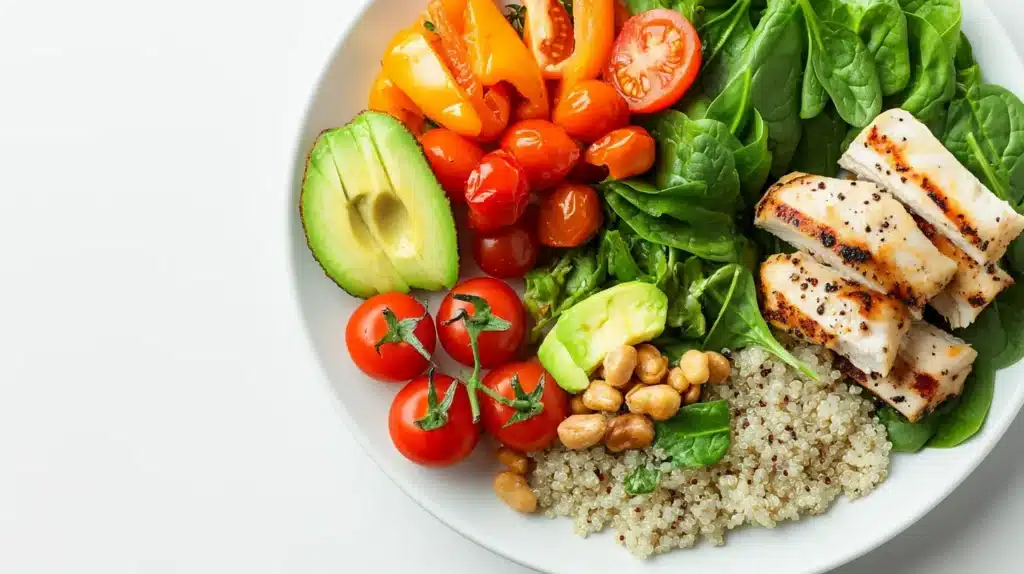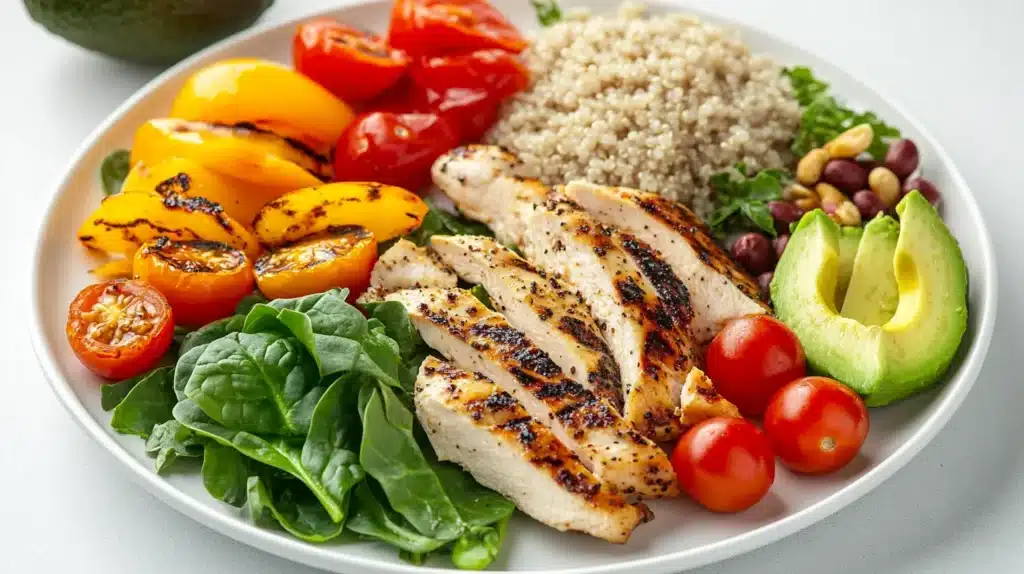Maintaining a balanced diet is essential for overall health and well-being, and understanding what is a healthy lunch plate can help you make better dietary choices. Lunch plays a crucial role in providing the necessary nutrients to sustain energy levels, support focus, and promote long-term wellness. A well-balanced lunch should not only satisfy hunger but also ensure that your body gets the right balance of macronutrients and micronutrients.
In this guide, we will explore what makes a healthy lunch plate, key food components, portion control, meal planning strategies, and practical tips for maintaining a nutritious diet. By following these recommendations, you can create delicious and well-balanced lunches that align with your health goals. For further insights, consider referring to the USDA MyPlate Guidelines, which provide structured advice on healthy eating.
Table of content
Table of content

What Is a Healthy Lunch Plate? Key Components for a Balanced Meal
A healthy lunch plate consists of a variety of nutrient-dense foods that provide essential vitamins, minerals, fiber, and proteins. The key to crafting a nutritious meal is incorporating different food groups in the right proportions. Below are the essential components:
1. Vegetables: The Foundation of a Nutritious Meal
Vegetables should take up half of your plate, as they provide fiber, vitamins, and antioxidants that promote overall health. Aim for a variety of colors to maximize nutrient intake.
✔ Best choices:
- Leafy greens (spinach, kale, arugula)
- Colorful vegetables (carrots, bell peppers, zucchini, tomatoes)
- Cruciferous vegetables (broccoli, cauliflower, Brussels sprouts)
2. Fruits: Natural Sweetness Packed with Nutrients
Fruits offer essential vitamins, minerals, and fiber while adding natural sweetness to your meal. However, portion control is important to avoid excess sugar intake.
✔ Best choices:
- Fresh fruits (apples, berries, oranges, bananas)
- Dried fruits (raisins, dates, figs) in moderation
- Citrus fruits for added vitamin C
3. Lean Proteins: Supporting Muscle Repair and Satiety
Protein should make up a quarter of your plate, as it plays a critical role in muscle repair and maintaining fullness.
✔ Best choices:
- Lean meats (chicken breast, turkey, fish)
- Plant-based options (tofu, lentils, chickpeas, black beans)
- Eggs and dairy (Greek yogurt, cottage cheese)
4. Whole Grains: Sustained Energy and Digestive Health
Whole grains provide long-lasting energy and are rich in fiber, helping with digestion and blood sugar regulation. They should fill the remaining quarter of your plate.
✔ Best choices:
- Brown rice, quinoa, bulgur
- Whole-wheat bread, whole-grain pasta
- Oats, barley
5. Healthy Fats: Essential for Brain Function and Heart Health
Healthy fats improve nutrient absorption and contribute to heart health. While they should be consumed in moderation, they are a crucial component of a balanced lunch plate.
✔ Best choices:
- Avocados, nuts, and seeds
- Olive oil, flaxseed oil
- Fatty fish (salmon, mackerel, sardines)
Mastering Portion Control for a Well-Balanced Healthy Lunch Plate
Portion control isn’t about eating less—it’s about eating smart. By learning how to balance the right types of foods in proper amounts, you can avoid overeating, support your health goals, and feel satisfied after every meal.
🔢 General Portion Breakdown
Use the plate method to visualize your portions and build a nutritionally balanced lunch:
- 🥦 Vegetables: ½ of your plate
Focus on non-starchy vegetables like leafy greens, cucumbers, bell peppers, broccoli, or zucchini. They’re low in calories but packed with fiber, vitamins, and minerals that keep you full and energized. - 🍗 Lean Proteins: ¼ of your plate
Include options like grilled chicken, tofu, legumes, or fish. Protein is essential for muscle repair, satiety, and maintaining a healthy metabolism. - 🍚 Whole Grains: ¼ of your plate
Choose complex carbs like brown rice, quinoa, whole-wheat pasta, or oats. They release energy slowly and help maintain stable blood sugar levels. - 🥑 Healthy Fats: A small portion (about the size of your thumb or 1–2 tablespoons)
Add avocado, a drizzle of olive oil, nuts, or seeds. These support heart and brain health and help absorb fat-soluble vitamins (like A, D, E, and K).
🧠 Mindful Eating Tips for Portion Control
- Use smaller plates or bowls: This visual trick makes your meal look bigger and helps you feel satisfied with less food.
- Start with vegetables: Fill half your plate first with veggies, so you’re naturally limiting space for less nutrient-dense items.
- Listen to your hunger cues: Pause halfway through your meal—ask yourself if you’re still hungry or just eating out of habit.
- Avoid distractions: Eating while watching TV or scrolling can lead to mindless overeating. Sit down, focus on your food, and enjoy every bite.
- Slow down: Chew thoroughly and take your time. It takes about 20 minutes for your brain to register fullness!
🍱 Portion Control Made Easy: Quick Visual Cues
If you’re not using a plate or don’t have measuring cups handy, here are some simple hand-based portion guides:
- ✋ Vegetables = 2 open palms
- ✊ Whole Grains or Carbs = 1 cupped hand
- ✋ Protein = Size of your palm
- 👍 Healthy fats = Size of your thumb
- 🥄 Nut butters or dressings = 1–2 tablespoons
🕐 Meal Timing & Frequency Tips
- Don’t skip lunch—it often leads to bigger portions later.
- Plan small, healthy snacks between meals if you feel hungry (like fruit + nuts or yogurt + berries).
- Stay hydrated! Sometimes thirst is mistaken for hunger.
By practicing portion control, you’re not restricting yourself—you’re empowering yourself to eat with intention and balance. 💪🥗 It’s one of the simplest but most powerful tools for maintaining a healthy lifestyle.ndfully—chewing slowly and savoring every bite—also prevents overeating.

Meal Planning and Preparation: Making Healthy Lunches Easy
Planning your lunches ahead of time ensures that you make healthier choices and avoid processed, high-calorie meals. Here are some strategies:
Smart Meal Prep Tips:
✔ Cook grains and proteins in bulk for the week. ✔ Store meals in portion-controlled containers. ✔ Rotate recipes to maintain variety and avoid boredom. ✔ Pack your lunch the night before to save time.
Quick and Healthy Lunch Plate Ideas:
✅ Lentil Soup – High in protein and fiber, perfect for meal prep. ✅ Veggie Wrap with Hummus – A plant-based, nutrient-dense option. ✅ Grilled Chicken Salad – A protein-packed meal with fresh greens. ✅ Quinoa & Roasted Vegetables – A fiber-rich, satisfying dish.
For additional inspiration, check out Healthy Pasta Recipes that incorporate whole grains and vegetables.
Practical Tips for a Nutrient-Dense Healthy Lunch Plate
What Is a Balanced Meal for Lunch?
A balanced meal for lunch includes a variety of nutrient-dense foods that provide essential macronutrients (carbohydrates, proteins, and healthy fats) and micronutrients (vitamins and minerals). A well-balanced lunch should contain:
.Vegetables (half of your plate) – Leafy greens, bell peppers, carrots, or broccoli.
.Lean Protein (one-quarter of your plate) – Chicken, fish, tofu, beans, or eggs.
.Whole Grains (one-quarter of your plate) – Brown rice, quinoa, whole wheat bread, or whole-grain pasta.
.Healthy Fats (small portion) – Avocados, nuts, seeds, or olive oil.
✅ Example Meal: Grilled salmon with quinoa, roasted Brussels sprouts, and avocado slices.
What Is the Healthiest Meal for Lunch?
The healthiest lunch is one that is nutritionally balanced, minimally processed, and packed with whole foods to keep you energized. A healthy meal should:
Be rich in fiber to support digestion.
Contain lean protein to keep you full.
Include complex carbohydrates for sustained energy.
Have healthy fats for brain function and heart health.
✅ Example Meal: Spinach salad with grilled chicken, cherry tomatoes, quinoa, walnuts, and a lemon-olive oil dressing.
What Is a Good MyPlate Lunch?
The USDA MyPlate recommends dividing your plate into four sections to ensure a well-rounded, nutritious meal:
.½ Plate: Fruits & Vegetables (e.g., steamed broccoli, cherry tomatoes, apple slices).
.¼ Plate: Protein (e.g., grilled turkey, lentils, tofu).
.¼ Plate: Whole Grains (e.g., whole wheat pasta, brown rice, whole grain wrap).
.Dairy on the Side: A serving of low-fat dairy (e.g., Greek yogurt, cheese, or milk).
✅ Example Meal: Grilled chicken wrap with whole wheat tortilla, lettuce, tomato, avocado, and a side of Greek yogurt with berries.
What Is the Healthiest, Most Balanced Meal?
The healthiest and most balanced meal is one that:
Includes a variety of nutrients to support overall health.
Focuses on whole, unprocessed foods rather than refined ingredients.
Maintains portion control to prevent overeating.
✅ Ultimate Balanced Meal Example: Baked salmon, quinoa, steamed asparagus, a mixed green salad with olive oil dressing, and a handful of almonds.
This kind of meal ensures protein for muscle maintenance, fiber for digestion, healthy fats for heart health, and vitamins for overall wellness. 💚

Final Thoughts: Build Your Healthy Lunch Plate Today!
Creating a healthy lunch plate is simple when you follow the right portion guidelines and include a variety of nutritious ingredients. By integrating lean proteins, whole grains, vegetables, fruits, and healthy fats, you can build meals that nourish your body and sustain energy throughout the day. Start experimenting with different food combinations and meal prep strategies to discover what works best for your lifestyle.
Your health journey begins with your plate—take the first step today and enjoy the benefits of nutrient-dense, delicious meals!
